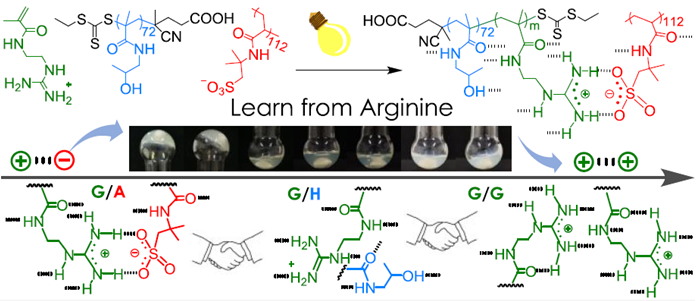Polymerization-Induced Electrostatic Self-Assembly Governed by Guanidinium Ionic Hydrogen Bonds
Weixing Xiong, Xiyu Wang, Yuanyuan Liu, Caihui Luo, Xinhua Lu, and Yuanli Cai*(蔡远利)
State-Local Joint Engineering Laboratory for Novel Functional Polymer Materials, Jiangsu Key Laboratory of Advanced Functional Polymer Design and Application, Suzhou Key Laboratory of Macromolecular Design and Precision Synthesis, College of Chemistry, Chemical Engineering and Materials Science, Soochow University, Suzhou 215123, China
Macromolecules 2022, 55, 7003--7012
Polymerization-induced electrostatic self-assembly (PIESA) represents a powerful method for the scalable synthesis of polyion complex (PIC) nanoparticles with various morphologies. Previous PIESA was driven by Coulombic interactions. Yet, biomimetic multivalent interactions, e.g., ionic hydrogen bonds omnipresent in proteins and potentially enabling access to new materials, remain unexplored. Herein, we update PIESA using arginine-like full-spectrum guanidinium ionic hydrogen bonds. Kinetic studies unravel that, at guanidinium-starving n+/n− (0.84), guanidinium interactions evolve from opposite-charge (6−73% conversion) into like-charge ionic hydrogen bonds (84 to >99% conversion), leading to ultrasmall clusters (2−5 nm, at 6−84% conversion) and size-tunable “large compound micelles” (14−25 nm, at 90 to >99% conversion). Longer guanidinium-block length results in the transformation of charge-neutral worms to positive-charge micron-scale large-area monolayer lamellae to multilayer platelets to tubular networks to vesicular aggregates, suggesting that the like-charge ionic hydrogen bonds are strong enough to overwhelm Coulombic repulsive interactions, and thus to revolutionize our PIESA chemistry for the precision synthesis of nextgeneration nanostructured biomimetic functional materials.

链接://pubs.acs.org/doi/full/10.1021/acs.macromol.2c01323